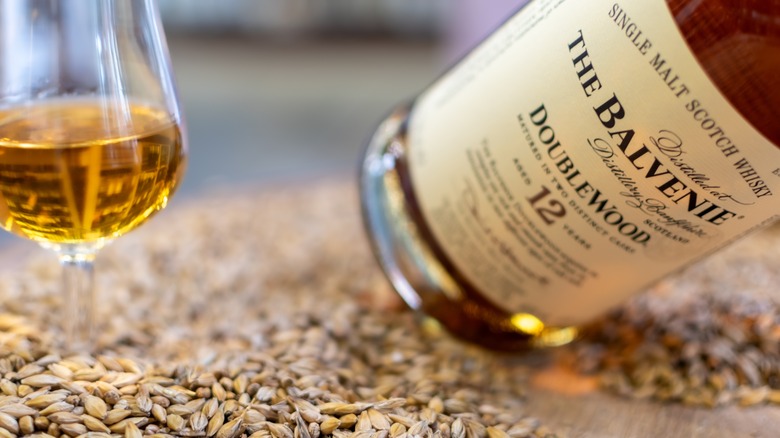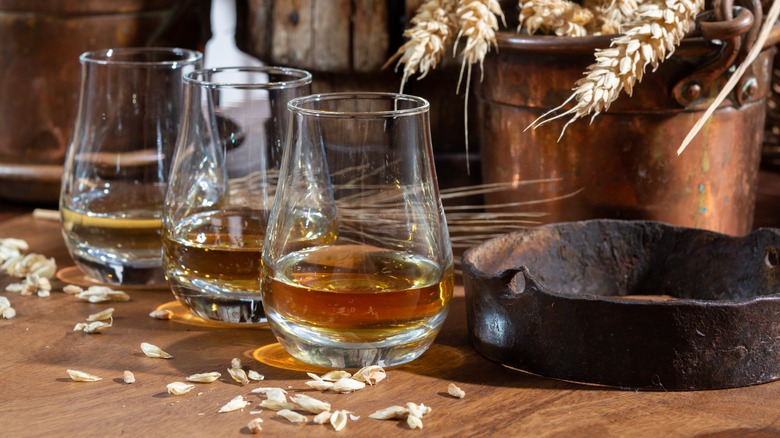What Is Scotch Made From Actually?
There's lots to love about whiskey, with its regional nature an especially captivating property. It's intriguing to sample liquors from different places, noting the unique ingredients, distillation methods, and barrel qualities that go into a spirit's terroir. And for drinkers who like to get especially technical — and don't mind their spirit a bit more aromatic — Scotch is a special candidate.
This whisky is world renowned for its complex palate, which covers a broad range of tasting notes, and oftentimes transmits unique regional qualities. The way the spirit's ingredients mingle is captivating; expressions like single malt really showcase the delicious components of a particular place. So knowing what ingredients comprise Scotch not only aids in understanding its flavor, but revered status, too.
As it so often goes, the base ingredients are simple: water, yeast, and grain. Yet just like there are differences between whiskey and bourbon, Scotch comprises more detailed specifics. By federal regulation, there may be no additives to this trio, and both distillation and barrel aging must take place Scotland. While there's no legal requirement for the grains to be Scottish, most are grown in the country. Malted barley is the traditional and most popular choice, although wheat and rye also appear in the mix. It's upon such a grain composition — as well as whether or not the whisky's blended — that Scotch is delineated into its main types.
Single malt Scotch employs exclusively malted barley
Scotch malt whisky is the most regulated sub-style, necessitating that the spirit is made from exclusively a malted barley mash that's distilled in a pot still. Whenever the entire production comes together under the roof of one distillery, it's called single malt, but there are also renditions blended across producers. In the beginning, all Scotch was made in this way, but its small-batch, low-yield, and inconsistent nature made it fall out of commercial success until a 1960s resurgence.
Nevertheless, today it's one of the most venerated types, with single malt bottles among the priciest whiskies. It's all due to the how the style showcases its ingredients — locally sourced malts mingle with local water and yeast to transmit delectable regional qualities. Throw in distinct manufacturing processes, like the smokey peating process common in Islay or the sherry-casks employed in Speyside, and a whole range of delicious flavors emerge.
Single malt Scotch can taste smokey and rich or fruity, bright, and sweet — there's not a defined palate, other than the fact it tends to be bold. Instead, there's special intrigue in such a variable nature, examining how different ingredients translate to the flavor batch by batch. It's a complexity furthered with producers selecting harvest season and strain of their grain. Not to mention whisky makers must also painstakingly malt the cereal through an elaborate process. As a result, all the care and detail of the ingredients intensely translates to the resultant liquor.
Other Scotch varieties incorporate more diversified grains
Malted barley is an undeniably delicious grain base, but it's not the only option for Scotch. In the 19th century, producers started incorporating a wider range of cereals, and distilling in a more efficient continuous still. This opened Scotch to a much wider array of ingredients: rye, corn, and wheat, with malting an optional step. Typically, such additions lightened the spirit's flavor, inspiring more sweet and smooth notes. Simultaneously, the new distillation method raised the spirit's ABVs.
As a result, grain whiskies emerged as the perfect blend base, which led them to dominate the Scotch market. Bottlings composed of several grains are easier to maintain across batches — it's what you'll see in widely available liquors like Costco's Kirkland Brand Scotch. And such mixes come in several forms, like blended Scotch made with a malted barley paired with a grain blend as well as blended grain Scotch, which contains several grain whiskies. Although rare, there are also single grain Scotches, which are produced from a mash bill distilled at only one premise.
Since mash bills can have varying ratios of cereals, and distilled Scotch is then blended in different ratios, such production expands the liquor's possibility. It makes it difficult to predict the flavor based on ingredients alone, so there's no better method than to start sampling. So get your hands on a tasty rendition, and remember to practice some crucial storage tips for your good whiskey.


